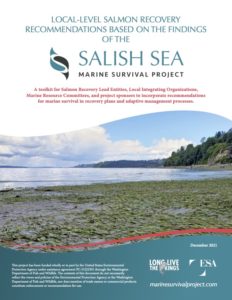The Marine Survival Project examined 21 hypotheses about the most likely factors influencing juvenile salmon survival in the Salish Sea. The evidence from more than 90 individual studies supports the conclusion that many different factors are important in marine survival, and that no single change is driving the decline. Complex interrelationships across the ecosystem are contributing to more challenging conditions overall. The Synthesis Committee, made up of the lead U.S. and Canadian scientists, reviewed all the findings to produce the final Synthesis Report and summary documents below. The Synthesis Report identified two overarching phenomena behind declining Salish Sea marine survival:
- Changes in food supply. Young salmon, especially Chinook and Coho, need more and larger prey as they grow during their early marine period. Shifting environmental conditions, including weather, nutrients, and temperature, appear to be driving shifts in both phytoplankton and zooplankton at the base of the food web. Climate change is a likely underlying factor behind these changes, but the complexity of these dynamics is still not fully understood, and is a crucial area for further research. At the same time, populations of forage fish, including herring and eulachon, have also declined in many parts of the Salish Sea, limiting another important food source for salmon.
- Increase in predators. Thanks to successful protections for marine mammals introduced on both sides of the border in the 1970s, harbor seal populations have exploded around the Salish Sea. While salmon and steelhead are a small component of the overall seal diet, the sheer number of seals means that even that small portion of their diet represents a major portion of juvenile salmon mortality – between 5 and 60 percent. Human-made changes in the environment contribute to predation “hot spots,” such as log booms or migration barriers like Puget Sound’s Hood Canal Bridge, where seals have easy access to large numbers of fish. Reduced availability of forage fish, lack of complexity in nearshore habitats, and the consolidated timing of Chinook hatchery releases may also affect the number of salmon consumed by seals in a given year or location.
Evidence also indicates that local factors contribute significantly to salmon health and survival in specific populations:
- Habitat degradation, especially in crucial estuary and nearshore marine habitats for juvenile Chinook
- Toxic contaminants near urban areas and hotspots of infectious agents in the Strait of Georgia
- Differences in behavior and life histories within and among salmonid species interact with all the other factors above.
Browse all publications, reports, and multimedia from project studies here.
Download the reports
 |
Summary Report and Recommendations (21 pages)Building a More Productive Salish Sea for Chinook Salmon, Coho Salmon, and Steelhead |
 |
Full Synthesis Report (142 pages) |
 |
Monitoring and Novel Research Techniques (15 pages) |
 |
A Collaborative Ecosystem Research Approach (11 pages)How Collaborative Ecosystem Research Addressed a Major Impediment to Salmon Recovery |
 |
Local Guidance Document for U.S. Entities (18 pages) |
Infographic: Summary of findings
